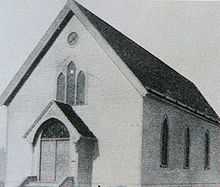Mount Zion Temple

Mount Zion Temple is a Reform synagogue located in St. Paul, Minnesota, United States. Founded in 1856 as Mount Zion Hebrew Association, it was the first Jewish congregation in Minnesota. The congregation was formed before the statehood of Minnesota in 1858.
Early on the congregation was divided by a group called Ahabath Ahim,[1] which branched off then returned.[2] 1871 was the year Rabbi Leopold Wintner began as Mount Zion's first and Minnesota's first Rabbi. In 1871, the congregation built the first Synagogue in the state.[3] The same year they founded the Hebrew Ladies Benevolent Society, members of which organized Neighborhood House to serve immigrants in the community.[4] The Rabbis and congregants of Mount Zion are still board members of Neighborhood House.[5]
Emanuel Hess, who had been born in Meerholz, Germany in 1845, became rabbi in 1888.[6] He had previously served as rabbi of Temple Israel of Columbus, Ohio in 1876–1877,[7] and then Congregation B'nai Zion in Shreveport, Louisiana, where he served until 1888. Hess was rabbi of Mount Zion until his death in 1906.[6]
In the 1940s the congregation participated in recreations such as "The Jewish Home Beautiful" which shared traditions of daily life.[8] In 1948, began the leadership of Rabbi Gunther Plaut, who published books on the congregation's history[9] and on the Jewish history of Minnesota. In the 1950s, the congregation chose architect Erich Mendelsohn to design a building for them. After projects in Europe, the Soviet Union, Israel and America - this was his final building, and it was completed after his death in 1953.[10] The congregation moved into the current building in 1956, 100 years after it was first founded. It is located on Summit Avenue.
In 2002, the Mount Zion Temple was part of a radio program that detailed their restoration of Torah scrolls.[11] In 2007, 690 families were members of the congregation.[12] As of 2012 the rabbis were Adam Stock Spilker and Esther Adler, and the cantors were Rachel Stock Spilker and Jen Strauss-Klein.[13]
See also
- List of Minnesota Synagogues
References
- ↑ Hebrew: אהבת אחים English: Brotherly Love
- ↑ Olitzky, Kerry M.; Raphael, Marc Lee. The American Synagogue: A Historical Dictionary and Sourcebook, Greenwood Press, June 30, 1996, ISBN 978-0-313-28856-2, pp. 189-191.
- ↑ Rosenblum, Gene H. Jewish Pioneers of St. Paul, 1849-1874 Arcadia Publishing, 2001, ISBN 0-7385-1862-X, p. 79.
- ↑ Berman, Hyman; Mack Schloff, Linda. Jews in Minnesota, Minnesota Historical Society Press, 2002, ISBN 0-87351-418-1
- ↑ Rosenblum, Gene. The Lost Jewish Community of the West Side Flats, 1882-1962, Arcadia Publishing, 2002, ISBN 0-7385-1986-3, p. 59-60.
- ↑ 6.0 6.1 Brock, Eric J. The Jewish Community of Shreveport, Arcadia Publishing, 2003. ISBN 978-0-7385-1488-8, p. 35.
- ↑ Olitzky, Kerry M.; Raphael, Marc Lee. The American Synagogue: A Historical Dictionary and Sourcebook, Greenwood Press, 1996, ISBN 978-0-313-28856-2, p. 290.
- ↑ Sarna, Jonathan D.. American Judaism: A History, Yale University Press, 2005, ISBN 0-300-10976-8, pp. 269-270.
- ↑ Plaut, W. Gunther. Mount Zion, 1856-1956: The First Hundred Years, North Central Pub. Co., 1956.
- ↑ Kidder Smith, George Everard. Source Book of American Architecture: 500 Notable Buildings from the 10th Century to the Present, Princeton Architectural Press, 1996, ISBN 1-56898-025-6, p. 409.
- ↑ Friend, Beth. "Torah Restoration'", National Public Radio, 18 May 2002.
- ↑ Roberts, Kate. Minnesota 150: The People, Places, and Things That Shape Our State, Minnesota Historical Society, 2007, ISBN 0-87351-594-3, p. 128.
- ↑ Mount Zion Temple, "Clergy/Staff", synagogue website. Retrieved December 28, 2009.